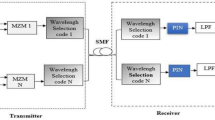Abstract
In this paper an adaptive mapping technique (AMT) is proposed for spectral amplitude coding-optical code division multiple access (SAC-OCDMA) system. The main purpose of the proposed technique is to construct codes whose length varies adaptively with the number of users. This task can be easily accomplished by successive offsets of the basic code matrix. The important benefit is that all the codes resulting from this technique have a zero cross-correlation property even if the basic code matrix doesn’t check it. Therefore, the AMT technique effectively reduces both MAI and PIIN. SAC-OCDMA system employing AMT is mathematically analyzed and then numerically simulated using Matlab. The results show the improvement given by this mapping technique to the SAC-OCDMA system. It illustrate that the proposed mapping technique can supports more users with a higher bit rate compared to the existing mapping techniques in the literature. The advantages of this technique have made it a compelling candidate for future OCDMA applications.







Similar content being viewed by others
References
Kadikar, R. U., & Prince, S. (2016). Software defined architecture on demand: A resilient node approach. In International conference on communication and signal processing (ICCSP). https://doi.org/10.1109/ICCSP.2016.7754084
Beson, M. R. C., Aljunid, A. S., Ghani, F., Anuar, M. S., & Fadhil, H. A. (2013). Alleviation noise effect using flexible cross correlation code in spectral amplitude coding optical code division multiple access systems. Journal of Communications, 8(2), 101–109.
Swadesh, M., & Islam, M. S. (2014). A new modified prime codes for higher user capacity in smart synchronous OCDMA network. In International conference on electrical engineering and information and communication technology (ICEEICT). https://doi.org/10.1109/ICEEICT.2014.6919134
Salehi, J. A. (1989). Code division multiple access technique in optical fiber networks, Part II: System performance analysis. IEEE Transactions on Communications, 37(8), 834–842.
Wei, Z. H., Shalaby, M., & Shiraz, H. G. (2001). New code families for fiber-Bragg-grating-based spectral amplitude-coding optical CDMA systems. IEEE Photonics Technology Letters, 13(8), 890–892.
Wei, Z. H., Shalaby, M. H., & Ghafouri-Shiraz, H. (2001). Modified quadratic congruence codes for fiber bragg-grating-based spectral amplitude-coding optical CDMA systems. Journal of Lightwave Technology, 19(9), 1274–1281.
Kakaee, M. H., Seyedzadeh, S., Fadhil, H. A., Ahmad, A. S. B., & Makhfudzah, M. (2014). Development of multi-service (MS) for SAC-OCDMA systems. Optics and Laser Technology. https://doi.org/10.1016/j.optlastec.2014.01.002.
Abd, T. H., Aljunid, S. A., & Fadhil, H. A. (2013). A new code design for spectral amplitude coding optical CDMA systems using fiber bragg-grating. Journal of Optics, 42(2), 110–115.
Ahmed, H. Y., & Nisar, K. (2013). Diagonal eigenvalue unity (DEU) code for spectral amplitude coding-optical code division multiple access. Optical Fiber Technology, 19(4), 335–347.
Hasoon, F., Aljunid, S., Abdullah, M., & Shaari, S. (2006). Spectral amplitude coding OCDMA systems using enhanced double weight code. Journal of Engineering Science and Technology, 1(2), 192–202.
Imtiyaz, W. A., Ilyas, M., & Yousaf, K. (2016). Performance optimization of spectral amplitude coding OCDMA system using new enhanced multi diagonal code. Journal of Infrared Physics and Technology. https://doi.org/10.1016/j.infrared.2016.09.006.
Pengfei, T., Ye, L., Huili, Z., Yao, P., Fan, G., & Chuanqi, L. (2018). Modified synchronous square prime code for SAC-OCDMA system using new partial balanced detection technique. Sidney, Australia. https://doi.org/10.1109/ICSENG.2018.8638172
Anuar, M. S., Alijunid, S. A., Saad, N. M., & Hamzah, S. M. (2009). New design of spectral amplitude coding in OCDMA with zero cross-correlation. Optics Communications, 282(14), 2659–2664.
Rashidi, C. B. M., Aljunid, S. A., Ghani, F., & Anuar, M. S. (2010). Development of modified zero cross correlation code for OCDMA network. In International conference on photonics. https://doi.org/10.1109/ICP.2010.5604406
Bhanja, U., & Panda, S. (2017). Comparison of novel coding techniques for a fixed wavelength hopping SAC-OCDMA. Photonic Network Communications. https://doi.org/10.1007/s11107-016-0632-5.
Mostafa, S., Mohamed, A. A., AbdEl-Samie, F. E., & Zaki, R. A. N. (2015). Eradication of multiple access interference using a modified multi-service code for SAC-OCDMA. Wireless Personal Communications. https://doi.org/10.1007/s11277-015-2430-2.
Abd, T. H., Aljunid, S. A., Fadhil, H. A., Ahmad, R. A., & Saad, N. M. (2011). Development of a new code family based on SAC-OCDMA system with large cardinality for OCDMA networks. Journal of Optical Fiber Technology, 17(4), 273–280.
Aljunid, S. A., Zan, Z., Ahmad, A. S. B., & Khazani, M. A. (2004). A new code for optical code division multiple access systems. Malaysian Journal of Computer, 17(2), 30–39.
Garadi, A., Djebbari, A., & Abdelmalik, T. A. (2017). Exact analysis of signal-to-noise ratio for SAC-OCDMA system with direct detection. Optik. https://doi.org/10.1016/j.ijleo.2017.07.038.
Waqas, A., Imtiaz, A., Ahmed, H. Y., Medien, Z. B., & Yahia, S. (2019). Analysis of noise suppression for OCDMA systems with fixed in-phase cross-correlation codes and single O/E converter. Optik - International Journal for Light and Electron Optics. https://doi.org/10.1016/j.ijleo.2019.02.052.
Ahmed, H. Y., Zeghid, M., Nisar, K. S., & Aljunid, S. A. (2017). Numerical method for constructing fixed right shift (FRS) code for SAC-OCDMA systems. International Journal of Advanced Computer Science and Applications (IJACSA), 8(1), 1546–1550.
Author information
Authors and Affiliations
Corresponding author
Additional information
Publisher's Note
Springer Nature remains neutral with regard to jurisdictional claims in published maps and institutional affiliations.
Rights and permissions
About this article
Cite this article
Hacini, L., Aissaoui, A. A Novel Mapping Technique for an Adaptive Length of Codes in SAC-OCDMA Systems. Wireless Pers Commun 123, 1103–1119 (2022). https://doi.org/10.1007/s11277-021-09172-x
Accepted:
Published:
Issue Date:
DOI: https://doi.org/10.1007/s11277-021-09172-x




